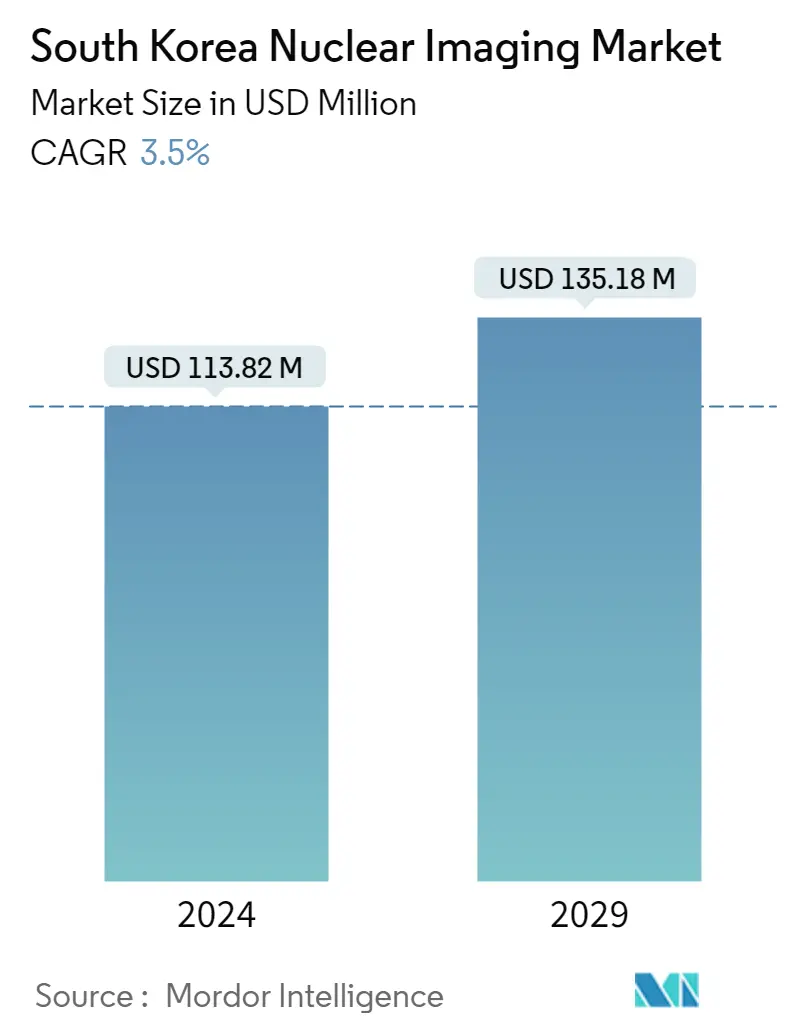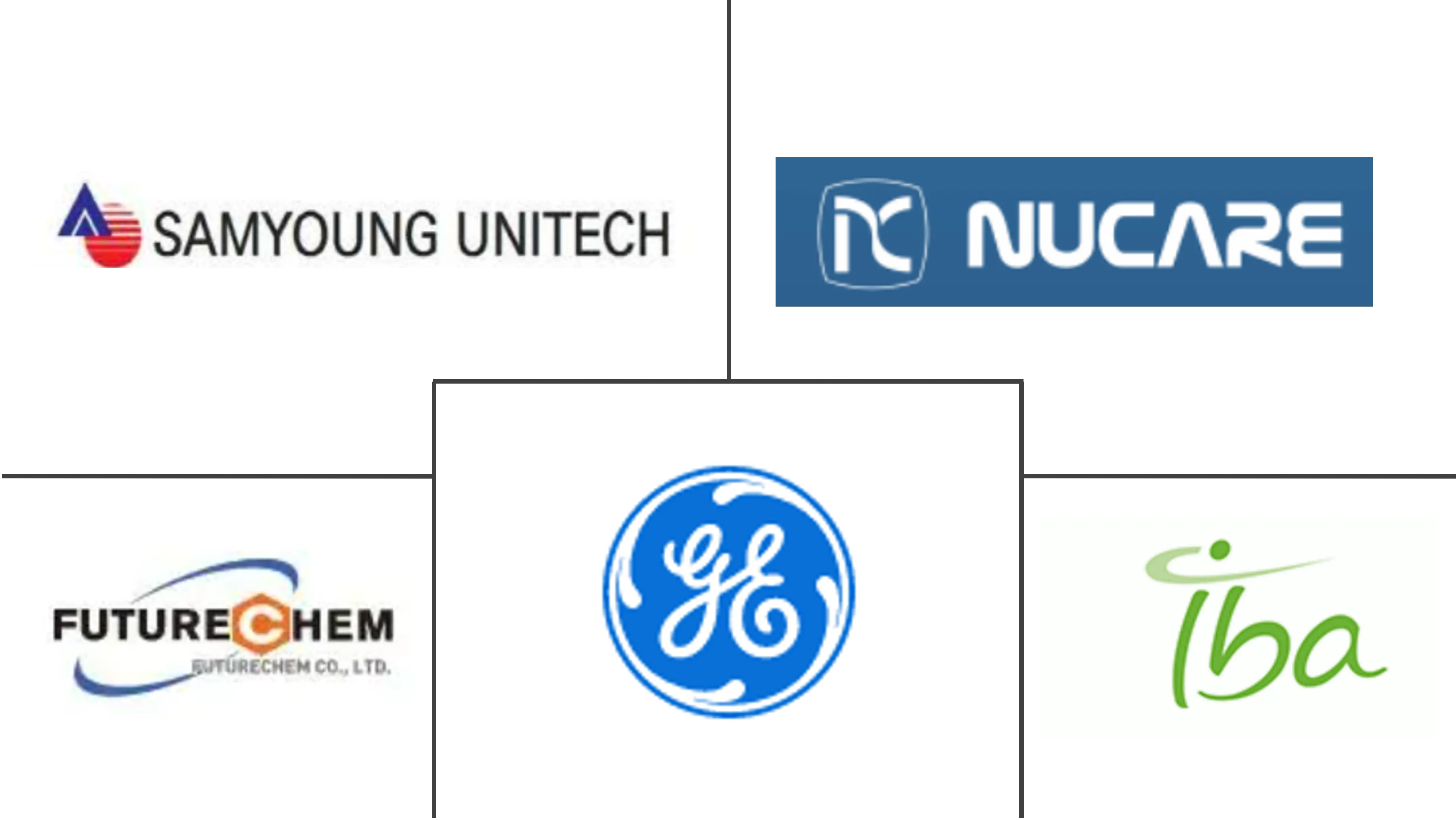Market Size of South Korea Nuclear Imaging Industry

| Study Period | 2021 - 2029 |
| Base Year For Estimation | 2023 |
| Market Size (2024) | USD 113.82 Million |
| Market Size (2029) | USD 135.18 Million |
| CAGR (2024 - 2029) | 3.50 % |
| Market Concentration | Medium |
Major Players
*Disclaimer: Major Players sorted in no particular order |
South Korea Nuclear Imaging Market Analysis
The South Korea Nuclear Imaging Market size is estimated at USD 113.82 million in 2024, and is expected to reach USD 135.18 million by 2029, growing at a CAGR of 3.5% during the forecast period (2024-2029).
The outbreak of the COVID-19 pandemic has pushed the healthcare industry into action, with a race to develop both therapeutic and preventive drugs. Initially, the outbreak of the pandemic adversely impacted the market in South Korea. For instance, according to a study published in NCBI in June 2021, a web-based survey conducted from March to April 2020 for the Asian Regional Cooperative Council for Nuclear Medicine and Asia Nuclear Medicine Board communities, highlighted a significant reduction in nuclear medicine practice and radioisotope supply at the onset of the COVID-19 pandemic. Therefore, such a scenario restrained the market growth at the initial times of the pandemic. However, the same study also reported that a second follow-up survey was conducted from March to April 2021 which clearly stated the recovery of both nuclear medicine practice and radioisotope supply. It also reported that various communications and educational sessions were also actively performed online in the Asian nuclear community during the pandemic. Therefore, during the initial days of the pandemic the market witnessed a slow growth, however in the later times with the positive developments the market gained momentum and is expected to maintain the upward trend over the forecast period.
The rise in the prevalence of cancer and the growth in applications of nuclear medicine and imaging are the major drivers for the market. For instance, as per the NCBI study published in January 2021, South Korea has seen a rapid increase in the incidence of colorectal cancer. It also stated that South Korea had the second-highest incidence of colorectal cancer worldwide in 2020, with an estimated rate of 44.5 cases per 100,000 persons per year. Nuclear imaging helps healthcare professionals to diagnose and treat cancer with high efficiency. Therefore, increasing incidence of cancer cases is anticipated to propel the demand for nuclear imaging, thereby surging the market growth.
The rising cases of cardiovascular diseases and technological advancements are also driving market growth. For instance, as per the study published in NCBI in June 2021, in South Korea, the incidence and mortality rate of cardiovascular diseases have increased for decades and the burden of cardiovascular diseases is still likely to increase. Similarly, as per the survey published by ScienceDirect in April 2022, the awareness regarding cardiovascular diseases among Korean women is extremely low and does not consider it an important health issue. Therefore, government and key players should take initiative to create awareness regarding cardiovascular diseases and screening of cardiovascular diseases which in turn may create opportunities for the market. Therefore, owing to such instances considerable market growth is anticipated over the forecast period.
However, the high cost of the techniques and the short half-life of radiopharmaceuticals are expected to hinder market growth over the forecast period.
South Korea Nuclear Imaging Industry Segmentation
As per the scope of the report, nuclear imaging encompasses gamma, SPECT, and PET imaging techniques. Nuclear medicine imaging procedures are non-invasive and, except for intravenous injections, are usually painless medical tests that help physicians diagnose and evaluate medical conditions. These imaging scans use radioactive materials called radiopharmaceuticals or radiotracers. The South Korea Nuclear Imaging Market is segmented by Product (Equipment (Single Photon Emission Computed Tomography (SPECT), Positron-emission Tomography (PET)) and Radioisotope (SPECT Radioisotopes and PET Radioisotopes)) and Application (Orthopedics, Thyroid, Cardiology, Oncology, and Others). The report offers the value (in USD million) for the above segments.
| By Product | ||||
| ||||
|
| By Application | |
| Orthopedics | |
| Thyroid | |
| Cardiology | |
| Oncology | |
| Others |
South Korea Nuclear Imaging Market Size Summary
The South Korea nuclear imaging market is poised for steady growth over the forecast period, driven by the increasing prevalence of cancer and cardiovascular diseases, alongside technological advancements in nuclear medicine. The market experienced initial setbacks due to the COVID-19 pandemic, which disrupted nuclear medicine practices and radioisotope supply. However, recovery was swift, aided by online educational initiatives within the Asian nuclear community. The rising incidence of colorectal cancer and the growing applications of nuclear imaging for efficient diagnosis and treatment are significant factors propelling market expansion. Additionally, the demand for nuclear imaging in cardiology is on the rise, with techniques like single-photon emission computed tomography (SPECT) gaining traction due to their high sensitivity and specificity in diagnosing coronary artery disease and other conditions.
Despite the promising growth prospects, the market faces challenges such as the high cost of nuclear imaging techniques and the short half-life of radiopharmaceuticals, which could hinder progress. The competitive landscape is characterized by a mix of international and local players, including prominent companies like DuChemBIO Co. Ltd, GE Healthcare, and Siemens Healthineers, who are focused on continuous product development and offering competitive pricing. Initiatives like the Mars Shot Fund, aimed at advancing research in nuclear medicine and molecular imaging, highlight the ongoing commitment to innovation in the sector. Strategic partnerships, such as the one between Positron Corporation and NeusoftMedical Systems, further underscore the industry's focus on enhancing manufacturing and distribution capabilities for advanced nuclear imaging devices.
South Korea Nuclear Imaging Market Size - Table of Contents
-
1. MARKET DYNAMICS
-
1.1 Market Overview
-
1.2 Market Drivers
-
1.2.1 Rise in Prevalence of Cancer and Cardiac Disorders
-
1.2.2 Increase in Technological Advancements
-
1.2.3 Growth in Applications of Nuclear Medicine and Imaging
-
-
1.3 Market Restraints
-
1.3.1 High Cost of the Techniques
-
1.3.2 Short Half-life of Radiopharmaceuticals
-
-
1.4 Porter's Five Force Analysis
-
1.4.1 Threat of New Entrants
-
1.4.2 Bargaining Power of Buyers/Consumers
-
1.4.3 Bargaining Power of Suppliers
-
1.4.4 Threat of Substitute Products
-
1.4.5 Intensity of Competitive Rivalry
-
-
-
2. MARKET SEGMENTATION (Market Size by Value - USD Million)
-
2.1 By Product
-
2.1.1 Equipment
-
2.1.1.1 Single Photon Emission Computed Tomography (SPECT)
-
2.1.1.2 Positron-emission Tomography (PET)
-
-
2.1.2 Radioisotope
-
2.1.2.1 SPECT Radioisotopes
-
2.1.2.2 PET Radioisotopes
-
-
-
2.2 By Application
-
2.2.1 Orthopedics
-
2.2.2 Thyroid
-
2.2.3 Cardiology
-
2.2.4 Oncology
-
2.2.5 Others
-
-
South Korea Nuclear Imaging Market Size FAQs
How big is the South Korea Nuclear Imaging Market?
The South Korea Nuclear Imaging Market size is expected to reach USD 113.82 million in 2024 and grow at a CAGR of 3.5% to reach USD 135.18 million by 2029.
What is the current South Korea Nuclear Imaging Market size?
In 2024, the South Korea Nuclear Imaging Market size is expected to reach USD 113.82 million.

